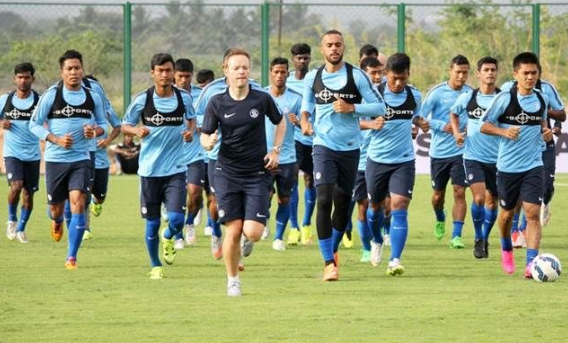Castles in the Air: Formations & Tactics Mean Little in Indian Football Without Planning From Ground Up

Debate regularly rages about what the Indian national football team’s formation should be, derived mostly from the successful club teams in the country. Most disregard the advantages franchise coaches have — that of using foreign players. For the Indian t
Chuni Goswami is considered by many the finest footballer India has produced. When the Indian team were considered the continent’s best side in the first half of the 1960s, he was not only its captain, but truly the jewel in its crown.
Chuni’s dazzling skills, dribbling ability, body feints and stunningly accurate volleys made him the darling of the crowd. He was the first superstar of Indian football. Never known to be a shy character, he always loved to talk about the golden days of Indian football, in detail.
Yet, there was an issue the Goswami always avoided discussing. Or should we say despised? Well, that won’t be far from the truth. Ask him about style of play and system or question him about the formation the Indian team should adapt to and Chuni would make a face that would leave one thoroughly discouraged.
Also Read | Football to Lose $14 Billion This Year, Says FIFA
Make no mistake, though. Sometime back, an All India Football Federation (AIFF) official called him a “silly dinosaur” after he criticised certain actions by the parent body. But he wasn’t that. In the late 1960s, when FIFA launched its first coaching course in Asia under legendary Dettmar Cramer, Chuni was a trainee in the first batch and passed with a First Class degree.
So, whatever doubts the AIFF had, it can safely be assumed that Chuni knew his football and had certain knowledge about systems and formations. But whenever asked, he would say, “why waste your time on such issues? Just, find out if your players have enough skills! Are they good enough to pass the ball correctly? Ensure these things and the system will always fall in line. Don’t make a simple thing complicated for no reason at all.”
But Indian football is no longer being run simply. It’s a “happening” game, they claim. The system and style of play is extremely important; sometimes more important than the outcome. A coach is judged on the formation he adapts to, not the results he brings to the table. Once an AIFF top official told this correspondent how he disliked Bob Houghton because he played the long-ball game! It hardly mattered that he helped India qualify for the AFC Asian Cup after 25 years.
Let’s not debate whether the said official ever kicked a ball or not. Who bothers? It is now more fashionable to deliberate whether India should go the English or the Spanish way. And since Spanish coaches currently have the upper hand in the country’s foreigners-dominated, cash-rich top league, the Spanish style of play gets many supporters.
So, should India play a 5-3-2? Or 4-5-1? Will they try 4-2-3-1 instead? These discussions take place as if hundreds of Indian footballers have already graduated from La Masia and are biting at the bit for an opportunity to make these formations a reality overnight. True, the coaches’ tactics in India’s top league are sometimes fascinating, educational, too. But they have the luxury of playing foreign players of their choice in the squad. But what about the national team, who struggle to find their feet against lowly Bangladesh and Afghanistan? And fail to show the minimum sense of tactics?
Also Read | More Than Just a Game: Naomi Osaka’s US Open Title Win is a Trinket. The Message is the Grand Slam
A certain school of thought in India feels that continuing with the age old 4-4-2 formation of play would be the best way for the national team, at least for the time being. Subhas Bhowmick, one of the more successful club coaches of the previous generation, however, is not ready to agree.
“Life is changing, so is football. We have our limitations, but that doesn’t mean we should hide behind the safety valve. Given a chance, I will rather go for a 4-1-4-1 combination. If I find the opponent weaker, I shall switch over to 4-3-3. Let us change the philosophy, for once at least. Let us play for a victory,” says the Asean Cup winning coach.
In a 4-1-4-1, Bhowmick thinks he can have some breakers on the pitch. Not having a defender who can tackle up front could be a problem. In this style of play, the ferocity of the stormy onslaughts could be tamed to an extent. That’s what Bhowmick plans to, at least.
The highly respected Derrick Pereira pauses to think when presented with the same issue. Once a brilliant footballer, he is now a highly respected coach. With a Pro license degree under his belt, Derrick was the India under-23 coach recently and is currently the technical director of FC Goa.
“4-4-2 for the national team? Yes, why not? After all, that’s a safe idea,” he says with a laugh. “At the same time, should one talk about the formation without looking at the players? After all, it is the quality of the players that makes a coach decide his formation.”
Derrick says it is not unusual to see a foreign coach coming to India with a certain philosophy in mind and enforcing it with determination. But, to reiterate, these coaches enjoy the luxury of having foreign players, many of whom are capable of strictly following the style of play. To follow the same tactics with the Indian national team could be difficult.
“Whatever the tactics and formations are, it should start from the age-group level. We should begin teaching them when they are young, so they can automatically graduate to the system. Not much change can be brought when they are at the senior level. Start where it should be. Not where they are supposed to produce results,” Derrick says.
Sukhwinder Singh is one of few Indian coaches, who had the privilege of managing the national team for nearly five years. He did justice to his job by producing some of the finest results with them, one that included a stunning win over United Arab Emirates in a World Cup qualifier. Sukhwinder was recently conferred the Dhyan Chand award, and still swears by the age-old 4-4-2 system.
His philosophy is simple. “Please don’t confuse yourself and the footballers as well. Train for the shape you need to play with and don’t allow it to be broken even under intense pressure. In what style you stand on the pitch at the start of the match is not important. How you stick to it during the course of play is the most necessary aspect.”
Also Read | Pause and Effect: Indian Super League Has a Calendar Problem
The veteran coach is unimpressed with the way the foreign coaches break the formation. “All coaches follow more or less the same formula. They take a certain stand when they have the upper hand. They will quickly put more men in defence when under pressure. It all depends on the quality of players. In modern football, every player will have to constantly go up and down, that’s the simple logic.”
One coach, who didn’t want to be quoted, had the best thing to say. “Why put the cart before the horse? First consider the fact whether you have enough players to back up your system. When you have only one decent central defender in the squad and no second striker to find the net, no amount of innovation in the system can rescue you from disaster. First think about the skills and then the system. Football matches are primarily won on skills, not system,” the coach said rather curtly.
The fact, however, is, the national coach Igor Stimac talks about a passing game that should start from the back and have an eye catching smoothness. He can’t be blamed. After all, football is all about chasing a dream and reaching the goal on the far side of the pitch. Once the pandemic is over (or controlled to an extent) he would return from Croatia to reinvent the shape he had been looking for.
But can he arrest the collapse and take India to the next Asia Cup with the system he had in mind? It is a million-dollar question for Indian football.
Get the latest reports & analysis with people's perspective on Protests, movements & deep analytical videos, discussions of the current affairs in your Telegram app. Subscribe to NewsClick's Telegram channel & get Real-Time updates on stories, as they get published on our website.
























